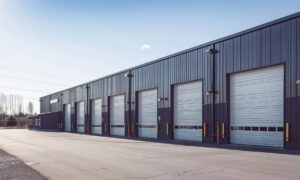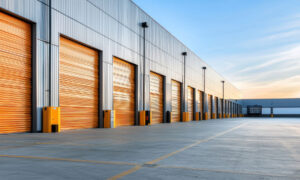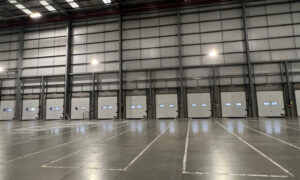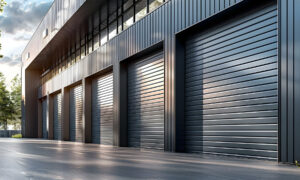You can find automated door systems in all kinds of settings — shopping malls, offices, healthcare facilities, factories and warehouses. But are automated doors the right choice for your commercial or industrial building?
Here, we look at the features and benefits of automatic doors. We also look at a couple of drawbacks to consider when deciding whether these are the right kind of doors for your business premises.
What are automated doors?
Automated doors are doors that open and close with minimal human involvement. They’re powered by electricity and are operated by sensors, push buttons or pressure pads.
You can find automated doors in both industrial and commercial buildings. They improve access to the building, making it easy for people to enter and exit quickly.
Types of automatic doors
Automatic industrial doors
You can find automatic industrial doors in factories and warehouses up and down the country. Types of automatic industrial doors include:
- industrial roller shutters — these doors are made from interlocking metal slats and they roll up to sit above a doorway
- sectional overhead doors — sectional overhead doors are made from hinged sections, which rise to sit along the ceiling of your building
- high speed doors — these doors open and close very quickly, making them useful for temperature-controlled and clean room spaces
- rapid repair doors — these doors self-repair when they come into contact with a vehicle, making them useful for high-frequency and heavy-duty operation
Automatic commercial doors
In commercial buildings, we tend to see sliding, swinging or revolving automatic doors. These automatic commercial doors come in a range of materials, including glass, wood, aluminium and steel.
Automatic door activation methods
When it comes to your automatic door opening system, there are yet more decisions to make. Here are some of the most common activation methods for automated doors.
Motion sensors
Motion sensors are programmed to detect movement. When a person or vehicle approaches the door, the sensors send a signal to the control mechanism and the door opens.
Push buttons
You can get automatic doors that open by pushing a button. Once a person has entered or exited the space, the door then closes automatically.
Pressure mats
Pressure mats sit in front of an automatic door. When a user stands on the pressure mat, the mat detects the increased weight. This triggers the door to open.
Proximity sensors
Proximity sensors detect electronic key cards or fobs carried by approved personnel. When the card or fob gets close enough to the sensor, the door opens automatically. This type of automatic door opening is useful if you want to control access to certain areas of your building.
Other features of automated door systems
As well as an activation method, automated door systems come with these other key features:
- Control system. The control system receives signals from the door activation method and then decides on the appropriate action. This system controls the speed and timing of the door’s movement.
- Motor and mechanism. The motor is the driving force behind an automated door’s movement. The mechanism is composed of components like the drive belt, gears and tracks. Together, the motor and mechanism ensure the smooth opening and closing of your doors.
- Safety features. Automatic door safety features prevent the door from opening or closing when there is a person or vehicle blocking the doorway. Doors also come with manual override mechanisms that allow people to open and close the door manually in times of emergency or power failure.
- Security. Automatic doors are no less safe and secure than manual doors. The best doors are made from heavy-duty materials and come with advanced locking systems.
- Cost. Automated door systems tend to cost more than manual doors — or doors that are operated by remote control. However, when deciding on your budget for industrial and commercial doors, remember that automated doors can improve your operations and reduce energy bills.
- Installation and maintenance. Automated door systems take a little longer to install than manual door systems. They also require regular servicing to ensure the door is working safely. Automatic door maintenance tasks include the cleaning of the sensors and door tracks, checking the motor and control systems and testing safety features.
What are the benefits of automated door systems?
There are lots of reasons to choose automated door systems for your industrial or commercial premises:
Accessibility
To open manual doors, you need some level of physical strength. But you can open and close automated door systems regardless of your physical ability. Automated doors make your business accessible to any workers and any customers.
Energy efficiency
Automatic doors open and close quickly — and there’s no danger that they’ll be left open accidentally. This reduces heat transfer and helps you maintain a stable temperature in your commercial or industrial building.
Hygiene
In industries where health and hygiene are a priority, automatic door systems are a great option. Because people don’t touch doors with their hands, they’re less likely to spread germs or other contaminants.
Streamlined operations
Automated door systems open and close quickly. In high traffic areas, like a busy warehouse, this helps to prevent bottlenecks. Personnel, vehicles and goods can move quickly from one space to another, ensuring speedy and streamlined business operations.
What are the disadvantages of automated door systems?
Automated door systems have a lot of benefits. They can quickly become an integral part of your business operations. However, there are some considerations to bear in mind. Here are the two key disadvantages of installing automatic doors at your business premises:
Should you choose an automated door system?
Automatic doors make your commercial or industrial building more accessible. They improve the flow of people and goods — and they make your premises more energy efficient too.
You can get automated door systems to fit almost any doorway. You can also take your pick from materials, finishes and activation methods. But automatic doors are always more expensive than manual doors — and they require a higher level of maintenance.
To work out whether automatic doors are the right choice for your business premises, get in touch with us here at Secure Door Systems. With years of experience fitting commercial and industrial automatic doors, we can advise you on the best solution for your business.






